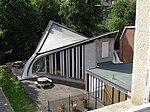Saddle roof
Appearance

A saddle roof is a roof form which follows a convex curve about one axis and a concave curve about the other. The hyperbolic paraboloid form has been used for roofs at various times since it is easily constructed from straight sections of lumber, steel, or other conventional materials.[1] The term is used because the form resembles the shape of a saddle.
Sometimes referred to as a hypar, the saddle roof may also be formed as a tensegrity structure.[2]
Mathematically, a saddle shape contains at least one saddle point.
The historical meaning is a synonym for a gable roof particularly a dual-pitched roof on a tower, also called a pack-saddle roof.[3]
Gallery
[edit]- Gallery of hyperbolic paraboloid structures
-
A hyperbolic paraboloid saddle roof: Church Army Chapel, Blackheath
-
A hyperbolic paraboloid saddle roof: The Scotiabank Saddledome in Calgary, 1983
-
A hyperbolic paraboloid saddle roof: the London Velopark
-
A hyperbolic paraboloid saddle roof: Scandinavium
-
Wrexham Swimming Baths, now Wrexham Waterworld Leisure and Activity Centre, feature a hyperbolic paraboloid roof in Wrexham, Wales, United Kingdom, 1969
-
Multi-semi-hyperbolic-paraboloid roofs on Canada Place, Vancouver, Canada

See also
[edit]- Sagrada Família
- eight hyperbolic parabolas rise to form the roof of Cathedral of Saint Mary of the Assumption and St. Mary's Cathedral, Tokyo.
- Hyperboloid structure
- List of hyperboloid structures
- Metro San Lázaro
- Xavier University
References
[edit]- ^ A Dictionary of Architecture, Fleming, Honour, Pevsner
- ^ Membrane Structures: Understanding Their Forms, Prof. Dr. Eng. M. Mollaert
- ^ Passmore, Augustine C.. "Saddle Roof". Handbook of technical terms used in architecture and building and their allied trades and subjects,. London: Scott, Greenwood, and Co.;, 1904. 303. Print.
External links
[edit]- Kansas State Historical Society newsletter featuring house with hyperbolic paraboloid roof.
- George Watson College, Edinburgh. Music auditorium









